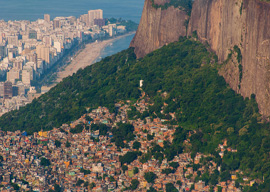
September 26, 2017

Favela da Rocinha, Rio de Janeiro, Brazil
Source: Bigstock
Race in Latin America is confusing to many Americans, who generally can’t see beyond black and white. Spanish and Portuguese conquistadores and their families from Europe have always formed a kind of local aristocracy. Their descendants were called criollos, and were considered somewhat lower in status than Iberians or other Europeans born abroad. The descendants of single European men who married native indio women formed the core of “the people,” who were subservient.
The possible combinations of different grades of European, Amerindian, and African led to a dizzying proliferation of types, all of which were named and classified according to a racial casta system. A mestizo is the historical name for a half criollo/half indio, a zambo for a half black/half indio. But these are only the better-known terms. Dozens of words for the possible combinations have existed, each with its own role, status, and class associations. There were even pictorial guides.
Racial diversity and integration are perfectly compatible with inequality and slavery—something those who celebrate America’s “nonwhite” or diverse future do not understand. In South America the casta system is no longer used so precisely, but even in our time the countries there remain racially stratified. Go to Rio de Janeiro and look in the boxes at the Teatro Municipal and you will see people as white as in France or Belgium. In Brazil, as well as in Colombia, Venezuela, and elsewhere, those classified as black unfortunately still have generally the lowest socioeconomic status. Then racism becomes based on hue, and usually the lighter you are in color, the higher you are in status.
Much is being written lately about Venezuela and its destructive socialism, but few understand or want to talk about the fact that it’s a socialism based on race and ethnicity, not Marxist theories. Hugo Chávez was proud of his distinctive look and called himself a pardo, a member of Venezuela’s oppressed mixed-race masses. The white elites of Venezuela are about 15 percent of the population and control most of the economy. Chávez’s government openly targeted them and drove the poor to racial resentment.
Conservatives, when they’ve spoken of race or ethnicity in Venezuela, have focused exclusively on “anti-Semitism.” But the government’s fulminations against Venezuela’s Jews are only part of a broader attack on European-descended Venezuelans and other “white” or “foreign” elites. It is Europeans, Spaniards, and peninsulares who are painted by the Chavistas as oppressors of Venezuela’s “real” people.
Establishment pundits don’t care to notice Venezuela’s abuse of whites as such, but American leftists are less naive and have long celebrated the racial character of Chávez’s revolution. “Set the Arabs on fire!”; “Be patriotic, kill a Turk!”—such graffiti is not found in Trump country, West Virginia, as CNN might have you believe, but in Tegucigalpa, Honduras. Racial demagoguery is widespread in Latin America. Lebanese and Palestinian Christians have long ruled the economy of Honduras, and the “socialist” regime of Manuel Zelaya relied on native ethnic mobilization against the domination of these “turcos.”
In Bolivia, Evo Morales led an openly ethnic movement of the country’s native indio population. In his rhetoric he sounds like an American college professor sputtering about the evils of privilege and white “colonialism.” In his inauguration Morales declared an end to the “Spanish” and European colonial Bolivia. He has even proposed to “revert” to a pre-Columbian calendar. (The day he resurrects the sacrifices and high rites of the old religion promises to be very exciting.) The wealthy and largely Spanish-Croatian city of Santa Cruz in the east of the country is not surprisingly seeking autonomy and maybe secession.
In Brazil the situation is not so extreme, but its milder racial politics are a lot more like what you’re starting to see in the United States. Rio de Janeiro has always had slums, but the favelas popularized by movies like City of God and Elite Squad mushroomed in size in the mid–20th century. Local politicians and nabobs were in search of the famous $2-per-day wage favored by oligarchs worldwide, so they imported a population that would work twelve hours a day in the hot sun for next to no pay from Brazil’s poor northeastern provinces. In one move, Rio’s oligarchs achieved both a decline in their labor costs and the political elimination of their traditional competitor, the middle class. The remaining rich Brazilians attained a life of freedom and luxury that is difficult for Americans to imagine.